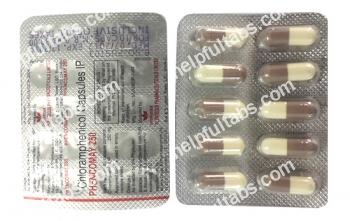













| Country | Shipping method | Delivery time | Price | |
|
|
 Delivery Delivery |
14-21 days | 10$ | Tracking# available in 4 days |
 Delivery Delivery |
9-14 days | 30$ | Tracking# available in 2 days |
Chloromycetin, one of the earliest natural antimicrobial medications developed in the late 1940s, has seen reduced usage due to widespread bacterial resistance and severe side effects. It is primarily used to treat meningitis, rickettsial diseases, salmonellosis, and anaerobic infections. Its mechanism involves blocking bacterial protein synthesis in ribosomes, making it bacteriostatic. However, at high concentrations, it can be bactericidal against pneumococci, meningococci, and H. influenzae. Chloromycetin is typically applied locally for eye infections and occasionally for bacterial meningitis, brain abscesses, generalized salmonellosis, typhoid fever, rickettsiosis (e.g., Q fever, Rocky Mountain spotted fever, typhus), intra-abdominal infections, pelvic infections, gas gangrene, and plague as a secondary treatment.
Use Chloromycetin only if safer, effective alternatives are unavailable. Take it exactly as prescribed, ensuring consistent dosing intervals. Avoid repeated treatments with the same medication. Swallow tablets with a full glass of water. Follow all instructions carefully when applying Chloromycetin liquid locally.
Inform your doctor about any other medical conditions and your allergy history, especially to antibiotics, before taking Chloromycetin.
In rare cases, Chloromycetin may cause severe, potentially fatal blood disorders such as bone marrow hypoplasia and aplastic anemia, necessitating regular blood monitoring. Antibacterial treatment can disrupt normal colon flora, leading to intestinal issues ranging from mild diarrhea to fatal colitis. Gray baby syndrome in neonates, characterized by hypothermia, cyanosis, flaccidity, and circulatory collapse, is often fatal.
Chloromycetin may prolong the effects of oral anti-diabetes medications and cause false-positive glucose test results in diabetic patients. Avoid co-administration with erythromycin or lincosamides. It can also reduce the effectiveness of medications containing iron, folic acid, and vitamin B12.
Never double the dose. If a dose is missed and the next one is due soon, skip the missed dose and continue the regular schedule.
Overdose symptoms may include easy bruising, bleeding, persistent sore throat, fever, unusual fatigue, headache, mild depression, mental confusion, rashes, or angioedema. Seek immediate medical help if overdose is suspected, especially if experiencing watery or bloody stools, with or without stomach cramps and fever.
Store at room temperature (59-77°F or 15-25°C), away from light, moisture, children, and pets. If refrigerated, do not freeze.
This information provides general guidelines and does not cover all directions, drug interactions, or precautions. It is not intended for self-treatment or self-diagnosis. Always consult your healthcare provider for personalized advice. We are not liable for the reliability of this information or any consequences arising from its use or self-treatment.